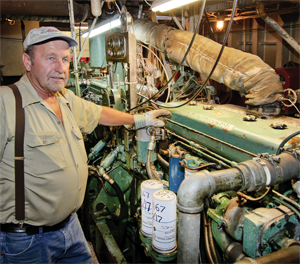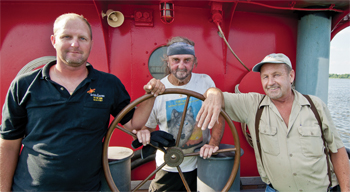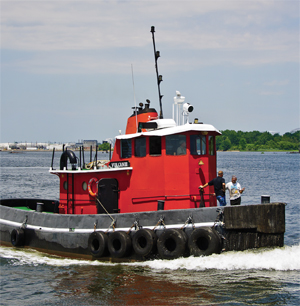In 1958, Blount Marine constructed four Vulcan class, 60-foot, 500-hp steel tugs in Warren, R.I. The boats, built for Bethlehem Steel, were built to last. One of them, Vulcan III, is owned by Capt. Butch Kitchell, owner of Derrick Marine in Perth Amboy, N.J.
“She’s built like a brick,” said Kitchell. “She’s got three-fourths-inch plate on the sides and half-inch on the bottom, and she weighs 130 tons.”
Kitchell acquired Vulcan III in 1996. In 2010, he placed first for best vintage tug and won the C class trophy in the annual Great North River Tugboat Race. “We were doing around 12 knots with a stern current and running between the wakes of two bigger boats,” he said, adding that with limited horsepower, you need some tricks to perform.
Kitchell’s son Derrick claims that the little red tugboat is the busiest boat in the harbor. The spelling of Derrick is correct, because he was named after the stiff-leg derrick Kitchell was working on when the baby was born. He took it a step further when he named his company. Kitchell’s name is actually Arthur G. Kitchell, and he is the third generation tugboater in the Kitchell family, after his grandfather, Leslie W., and his father, Arthur P. Representing the fourth generation is Derrick who’s name is actually Arthur D. Kitchell. His grandfather’s license was issued in February 1911 by the U.S. Department of Commerce.
 |
 |
|
Above, Capt. Kitchell stands next to one of the two 6110 Detroit Diesels, arranged back to back with a single shaft running under them turning a 58-inch propeller. A power takeoff on the front end of each engine runs much of the other machinery aboard, including a 105-cubic-foot-per-minute air compressor, as well as the bilge and fire pumps. Below, Derrick Kitchell, Engineer Joe Oltmann and Capt. Kitchell. The tug’s wide range of work includes setting piles, putting in docks and fenders and laying riprap. |
The propulsion in Vulcan III consists of two 6110 Detroit Diesels, back to back, with a single shaft running under them turning a 58-by-38-inch three-blade propeller. There is a power takeoff on the front end of each engine. The forward engine runs a 105-cubic-foot-per-minute air compressor, and the aft engine runs the salvage (bilge) pump and fire pump. Back in the day, it also ran the welding machines on deck.
“It’s a unique setup,” said Kitchell.
On a normal day, if such exists for a small and nimble tugboat in a harbor with a labyrinth of tight reaches, Kitchell maneuvers Vulcan III to setting piles, putting in docks and fenders or laying riprap on marine construction jobs for companies such as New York Waterway, New York Water Taxi, or the U.S. Coast Guard.
Kitchell likes backup. He has two Lister Petter spare generators, three three-blade propellers and one four-blade propeller.
His engineer, Joe Oltmann, installed an electric-over-hydraulic steering system with a joystick. Just in case, Kitchell keeps his big, heavy, bronze wheel in the house.
“The new steering is a dream, but I have the pin right here,” he said. “I can grab the wheel, put it on and set the pin and be ready to go in under a minute. When I did a job up at Hell Gate, with all that current, I put all my backups on board. I didn’t want to take a chance in there. It could have been embarrassing.”

